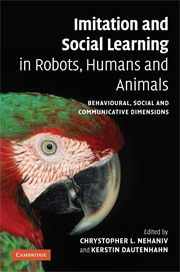 Imitation and Social Learning in Robots, Humans and Animals
Imitation and Social Learning in Robots, Humans and Animals Book contents
- Frontmatter
- Contents
- List of plates
- List of figures
- List of tables
- List of contributors
- Introduction: the constructive interdisciplinary viewpoint for understanding mechanisms and models of imitation and social learning
- Part I Correspondence problems and mechanisms
- Part II Mirroring and ‘mind-reading’
- Part III What to imitate?
- Part IV Development and embodiment
- Part V Synchrony and turn-taking as communicative mechanisms
- 13 How to build an imitator
- 14 Simulated turn-taking and development of styles of motion
- 15 Bullying behaviour, empathy and imitation: an attempted synthesis
- Part VI Why imitate? – Motivations
- Part VII Social feedback
- Part VIII The ecological context
- Index
- Plate section
- References
14 - Simulated turn-taking and development of styles of motion
Published online by Cambridge University Press: 10 December 2009
- Frontmatter
- Contents
- List of plates
- List of figures
- List of tables
- List of contributors
- Introduction: the constructive interdisciplinary viewpoint for understanding mechanisms and models of imitation and social learning
- Part I Correspondence problems and mechanisms
- Part II Mirroring and ‘mind-reading’
- Part III What to imitate?
- Part IV Development and embodiment
- Part V Synchrony and turn-taking as communicative mechanisms
- 13 How to build an imitator
- 14 Simulated turn-taking and development of styles of motion
- 15 Bullying behaviour, empathy and imitation: an attempted synthesis
- Part VI Why imitate? – Motivations
- Part VII Social feedback
- Part VIII The ecological context
- Index
- Plate section
- References
Summary
Intersubjectivity and turn-taking
We introduce a simulation study designed to develop a “synthetic psychology” (Braitenberg, 1984). Instead of studying real human/animal behavior, we study autonomous behavior of mobile agents that have virtual sensors to “see” the world and move around with virtual “wheels.” The autonomous behavior is synthesized by the agent's internal dynamics, which evolve using a genetic algorithm. A purpose of synthetic psychology is to create a new concept in order to understand an essential psychological phenomenon. Therefore, the simulation framework has to use models sufficiently simple to analyze the behavior, but sufficiently complex to provide a theory to understand the psychological experiments.
As an example of synthetic psychology, we describe a simulation study of turn-taking using coupled dynamical recognizers. Studying turn-taking phenomena in robot experiments (e.g. Brooks et al., 1999; Dautenhahn, 1999; Steels and Kaplan, 2001; Miyake et al., in press) stresses the importance of embodiment and situatedness. In particular, MIT AI Lab's well-designed face robot, Kismet (Kismet project, 2000), can make use of human social protocols to stimulate natural emotions and social responses in humans. Even conversational turn-taking is established with a human subject. To do this, Kismet relies on subtle cues of human expression and interaction dynamics. Dautenhahn et al. used a mobile robot and a small humanoid robot to investigate the use of robotic toys in therapy and education of children with autism (Dautenhahn et al., 2002; AuRoRA project, 2005). These robots engage in playing a game with autistic children to elicit turn-taking and imitation.
- Type
- Chapter
- Information
- Imitation and Social Learning in Robots, Humans and AnimalsBehavioural, Social and Communicative Dimensions, pp. 301 - 322Publisher: Cambridge University PressPrint publication year: 2007


